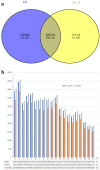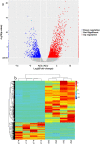Differentially expressed lncRNAs in liver tissues of TX mice with hepatolenticular degeneration
- PMID: 33446761
- PMCID: PMC7809420
- DOI: 10.1038/s41598-020-80635-0
Differentially expressed lncRNAs in liver tissues of TX mice with hepatolenticular degeneration
Abstract
Wilson's Disease (WD), an ATP7B-mutated inherited disease that affects copper transport, is characterised by liver and nervous system manifestations. Long non-coding (ln-c) RNAs are widely involved in almost all physiological and pathological processes in the body, and are associated with numerous diseases. The present study aimed to elucidate the lncRNA-mRNA regulation network in a TX WD mouse model using RNA sequencing (RNA-seq). lncRNA expression profiles were screened using RNA-seq and real-time polymerase chain reaction, and differentially expressed lncRNAs and mRNAs were identified. To analyse the biological functions and pathways for the differentially expressed mRNAs, gene ontology and pathway enrichment analyses were performed. A significantly correlated lncRNA-mRNA relationship pair was calculated by CNC analysis to construct differential lncRNA and mRNA co-expression networks. A total of 2564 significantly up-regulated and 1052 down-regulated lncRNAs, and 1576 up-regulated and 297 down-regulated mRNAs, were identified. These genes were found to be associated with key processes such as apoptosis, and KEGG analysis revealed enrichment in the drug metabolism-cytochrome P450 pathway, PPAR signalling pathway, Notch signalling pathway, and MAPK signalling pathway. The identified differential lncRNAs may be involved in the pathogenesis and development of WD liver injury.
Conflict of interest statement
The authors declare no competing interests.
Figures





Similar articles
-
Comprehensive analysis of the coding and non-coding RNA transcriptome expression profiles of hippocampus tissue in tx-J animal model of Wilson's disease.Sci Rep. 2023 Jun 7;13(1):9252. doi: 10.1038/s41598-023-36503-8. Sci Rep. 2023. PMID: 37286730 Free PMC article.
-
Expression signature of lncRNAs and their potential roles in cardiac fibrosis of post-infarct mice.Biosci Rep. 2016 Jun 3;36(3):e00337. doi: 10.1042/BSR20150278. Print 2016 Jul. Biosci Rep. 2016. PMID: 27129287 Free PMC article.
-
Effect of the traditional Chinese medicine Qi Teng Xiao Zhuo granules on chronic glomerulonephritis rats studied by using long noncoding RNAs expression profiling.Gene. 2020 Feb 20;728:144279. doi: 10.1016/j.gene.2019.144279. Epub 2019 Dec 9. Gene. 2020. PMID: 31821871
-
ATP Citrate Lyase and LncRNA NONMMUT010685 Play Crucial Role in Nonalcoholic Fatty Liver Disease Based on Analysis of Microarray Data.Cell Physiol Biochem. 2018;51(2):871-885. doi: 10.1159/000495384. Epub 2018 Nov 22. Cell Physiol Biochem. 2018. PMID: 30466110
-
Genome-wide analysis of long noncoding RNA (lncRNA) expression in colorectal cancer tissues from patients with liver metastasis.Cancer Med. 2016 Jul;5(7):1629-39. doi: 10.1002/cam4.738. Epub 2016 May 11. Cancer Med. 2016. PMID: 27165481 Free PMC article.
Cited by
-
Biomarker Discovery in Wilson's Disease-A Path Toward Improved Diagnosis and Management: A Comprehensive Review.Mol Neurobiol. 2025 Jun 18. doi: 10.1007/s12035-025-05143-6. Online ahead of print. Mol Neurobiol. 2025. PMID: 40531364 Review.
-
Role and mechanisms of cuproptosis in the pathogenesis of Wilson's disease (Review).Int J Mol Med. 2025 Aug;56(2):117. doi: 10.3892/ijmm.2025.5558. Epub 2025 Jun 6. Int J Mol Med. 2025. PMID: 40476570 Free PMC article. Review.
-
Identification of lncRNA-miRNA-mRNA Networks in the Lenticular Nucleus Region of the Brain Contributes to Hepatolenticular Degeneration Pathogenesis and Therapy.Mol Neurobiol. 2024 Mar;61(3):1673-1686. doi: 10.1007/s12035-023-03631-1. Epub 2023 Sep 27. Mol Neurobiol. 2024. PMID: 37759104 Free PMC article.
-
A grading method for Kayser Fleischer ring images based on ResNet.Heliyon. 2023 May 13;9(5):e16149. doi: 10.1016/j.heliyon.2023.e16149. eCollection 2023 May. Heliyon. 2023. PMID: 37234668 Free PMC article.
-
Wilson Disease: Update on Pathophysiology and Treatment.Front Cell Dev Biol. 2022 May 2;10:871877. doi: 10.3389/fcell.2022.871877. eCollection 2022. Front Cell Dev Biol. 2022. PMID: 35586338 Free PMC article. Review.
References
Publication types
MeSH terms
Substances
LinkOut - more resources
Full Text Sources
Other Literature Sources
Medical

